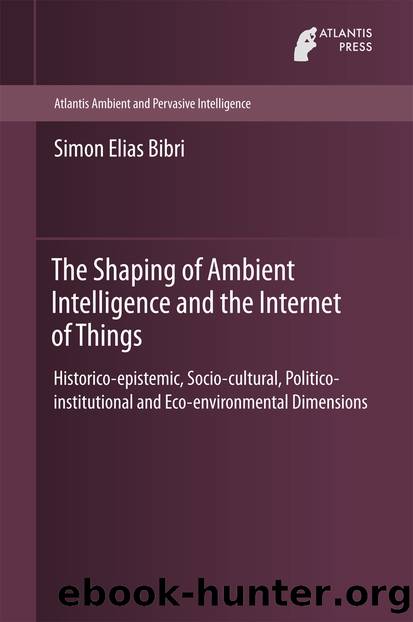The Shaping of Ambient Intelligence and the Internet of Things by Simon Elias Bibri

Author:Simon Elias Bibri
Language: eng
Format: epub
Publisher: Atlantis Press, Paris
5.4.2 Technocracy: A Repercussion of the Nature of Subject Positioning and Legitimation in the AmI and the IoT Discourses
Based on the above reasoning, the European society can be said to be of a technocracy nature, governed by technical experts—technocrats—in a number of fields of governmental decision making. In this context, technocrats include both members of powerful technical elites and those who advocate the supremacy of technical experts. Thus, given the information and knowledge character of European society, ICT industry, computer scientists and engineers, technologists, and entrepreneurial ICT companies may compose a major part of the governing body. Accordingly, decision and policy makers are selected based upon how knowledgeable, experienced, and skillful they are in such fields as ICT, AmI, computing, technology, social studies of new technologies, European studies of S&T, and so on. Thus, the application of technocracy here is the administration or management by specialized experts in any relevant field or discipline-specific science—ostensibly without the influence of lobbyists, special interest groups, advocacy groups, or corporations swaying decisions made by officials in the government, most often legislators or regulatory agencies. In fact, critical views assert that the characteristic feature of an information (or postindustrial) society is that it is a technocracy (e.g. Targ 1976), governed by technocrats who have knowledge and expertise, especially technologists. As implied by ISTAG (2001), a group of scholars and experts, it is up to technologists to keep up with the fast pace of chane and innovation and to engage in building the future, but eventually ‘it is up to us to decide our common future’. While there is no intention to make judgments about the divination of prospective, desired life-worlds, enunciated in the AmI vision, there are a few technical stakeholders (technologists) who have since the inception of the AmI vision evangelized it and continue to do so—although the vision postulates a paradigmatic shift in computing. As expressed by Emile Aarts, ‘we need to continue evangelizing the vision throughout Philips and Europe in order to make it come true’ (Aarts 2003, p. 5).
Download
This site does not store any files on its server. We only index and link to content provided by other sites. Please contact the content providers to delete copyright contents if any and email us, we'll remove relevant links or contents immediately.
Algorithms of the Intelligent Web by Haralambos Marmanis;Dmitry Babenko(16234)
Jquery UI in Action : Master the concepts Of Jquery UI: A Step By Step Approach by ANMOL GOYAL(9386)
Test-Driven Development with Java by Alan Mellor(7735)
Data Augmentation with Python by Duc Haba(7608)
Principles of Data Fabric by Sonia Mezzetta(7378)
Learn Blender Simulations the Right Way by Stephen Pearson(7294)
Microservices with Spring Boot 3 and Spring Cloud by Magnus Larsson(7137)
Hadoop in Practice by Alex Holmes(6587)
RPA Solution Architect's Handbook by Sachin Sahgal(6515)
The Infinite Retina by Robert Scoble Irena Cronin(6215)
Big Data Analysis with Python by Ivan Marin(5933)
Life 3.0: Being Human in the Age of Artificial Intelligence by Tegmark Max(5512)
Pretrain Vision and Large Language Models in Python by Emily Webber(4894)
Infrastructure as Code for Beginners by Russ McKendrick(4652)
Functional Programming in JavaScript by Mantyla Dan(4436)
WordPress Plugin Development Cookbook by Yannick Lefebvre(4382)
The Age of Surveillance Capitalism by Shoshana Zuboff(4243)
Embracing Microservices Design by Ovais Mehboob Ahmed Khan Nabil Siddiqui and Timothy Oleson(4146)
Applied Machine Learning for Healthcare and Life Sciences Using AWS by Ujjwal Ratan(4135)
